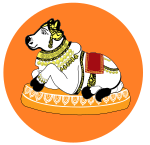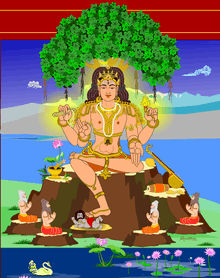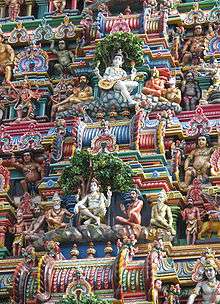Dakshinamurthy
Dhakshinamoorthy Sanskrit: दक्षिणामूर्ति (Dakṣiṇāmūrti)[1] is an aspect of the Hindu god Shiva as a guru (teacher) of all types of knowledge. This aspect of Lord Paramasiva Convected to Paramaguru is his personification as the supreme or the ultimate awareness, understanding and knowledge.[2] This form represents Shiva as a teacher of yoga, music, and wisdom, and giving exposition on the shastras.[3] He is worshipped as the god of wisdom, complete and rewarding meditation.[4] As per scriptures, if a person doesn't have a Paramaguru, then they can consider and worship Lord Dhakshinamoorthy as their Guru. Eventually they will be blessed with a human Self-Realised Guru, if they are worthy.
| Dakshinamurthy | |
|---|---|
Dakshinamoorthy Shiva sculpture on the southern entrance of the Meenakshi Temple in Madurai. | |
| Affiliation | Shiva (Shaivism) |
| Part of a series on |
| Shaivism |
|---|
 |
|
Scriptures and texts
|
|
Philosophy
|
|
Practices |
|
Schools
Saiddhantika Non - Saiddhantika
|
|
Related
|
Meaning

Dakshinamurti literally means 'one who is facing south (dakṣiṇa)' in Sanskrit. According to another school of thought 'Dakshinya' means Karuna in Sanskrit or kindness (benevolence). So this manifestation of Shiva is a benevolent teacher who accords wisdom to seekers of salvation. [5] In every Siva temple the stone image of Dakshinamurthy is installed, facing south, on the southern circumambulatory path around the sanctum sanctorum. Perhaps, of all Hindu Gods, he is the only one sitting facing south. The great seer Ramana Maharshi, has said in letter 89: one meaning of Dakshina is efficient; another meaning is ‘in the heart on the right side of the body’; Amurthy ’means Formlessness' . "Dakshinamurthy Stotra" in Sanskrit, means the "Shapelessness situated on the right side".

Depiction

In his aspect as Jnana Dakshinamurti, Shiva is generally shown with four arms. He is depicted seated under a banyan tree, facing the south. Shiva is seated upon a deer-throne and surrounded by sages who are receiving his instruction.[6] He is shown as seated with his right foot on mythical apasmara (a demon which, according to Hindu mythology, is the personification of ignorance) and his left foot lies folded on his lap. Sometimes even the wild animals, are depicted to surround Shiva. In his upper arms, he holds a snake or rosary or both in one hand and a flame in the other; while in his lower right hand is shown in vyakhyanamudra, his lower left hand holds a bundle of kusha grass or the scriptures. The index finger of His right hand is bent and touching the tip of his thumb. The other three fingers are stretched apart. This symbolic hand gesture or Mudra is the Gnana Mudra (or Jnana Mudra or Jana Mudra), a symbol of knowledge and wisdom. Sometimes, this hand is in the Abhaya Mudra, a posture of assurance and blessing. In Melakadambur the statue of the Dakshinamurthy appears seated on a bull under a banyan tree with a hole extending from one ear to the other.
Dakshinamurthy is portrayed as a powerful form brimming with ever-flowing bliss and supreme joy while being in the yogic state of abstract meditation. Variations of this iconic representation include Veenadhara Dakshinamurthy (holding a Veena) and Rishabharooda Dakshinamurthy (mounted on a Rishabha - the bull).
Significance

Indian tradition accords a special reverence to the Guru or the teacher. Dakshinamurthy, in the Hindu system of beliefs is regarded as the ultimate Guru - the embodiment of knowledge and the personification of ignorance (as represented by, the demon being crushed under the feet of the deity). The Jnana Mudra is interpreted in this way:- The thumb denotes the God and the index finger denotes the man. The other three fingers stand for the three congenital impurities of man viz. arrogance, illusion and bad deeds of the past births. When man detaches himself from these impurities, he reaches God. Another interpretation is that the other three fingers denote the three states of life: Jagruti (Fully awake through senses and mind), Swapna (Sleep state - When the mind is awake) and Sushupti (True-self - When the senses and mind go into soul - Atma). The Abhaya Mudra, a gesture with the hand lifted above thigh with palm facing out, fingers pointing, is interpreted as His grace upon His students. The rosary or the snake signifies tantric knowledge. The fire represents illumination, removing the darkness of ignorance.
Impact on Indian Life
The fifth day of the week, Thursday is associated with the planet Jupiter and is referred to as Guru (Guruvar or Guruvaaram). Thursdays are considered auspicious to start any educational endeavours. It is on Thursdays that special worship services are offered to Dakshinamurthy in many Saivite temples. Some temple traditions hold full moon nights, particularly the night of the Guru Purnima as the appropriate time for worship services to Dakshinamurthy.
Temples

Even though the idol of Dakshinamurthy is installed in every Shiva temple, there are only a few temples where Dakshinamurthy is the chief deity.
- Only one of the twelve Jyotirlingas is Dakshinamurthy, the Mahakaleshwar in Ujjain. Being the only Dakshinmurthy Jyotirlinga, It holds special importance for Shaivites as a site of learning.
- A 112 feet, South-facing Adiyogi Shiva statue (Adiyogi – The Source of Yoga) along with a linga called "Yogeshwar Linga"[7] was consecrated by Sadhguru Jaggi Vasudev, and inaugurated by Indian Prime Minister Narendra Modi on February 24, 2017.[8] It is located at the Isha Yoga Center in Coimbatore, India. The South-facing Adiyogi is seen as a representation of Dakshinamurthy, and is considered the Adi Guru or the first Guru.[9]
- Sree Dakshinamurthy Temple at Sukapuram, Edapal Taluk in Malappuram District, Kerala. Pratishtha was done by Suka Maharshi. Estimated 1500 years Old
- Ettumanoor Mahadevar Temple in Kerala, where the deity nshrined in the form of a Shivalingam is considered as Dakshinamurthy
- Alangudi, Kumbakonam, Tamil Nadu
- Sree Dakshinamurthy Temple at Pattamangalam village, in Sivagangai District, Tamil Nadu. It is estimated that this temple is nearly 500 years old.[10][11]
- In the Sivanandeswarar temple in Thirupanthurai, Tanjore, Tamil Nadu, He is depicted in the Ardhanari form.
- In Thirupulivanam, we can find Dakshinamurthy in the form of Ardhanariswara. This temple is on the Uthiramerur-Kanchipuram road, 5 km from Uthiramerur, near Chennai.
- In March 2007, a big temple of Lord Dakshinamurty (the first in Maharashtra) was created in the Shrutisagar Ashram, about 30 km from Pune
- Pragya Dakshinamoorthy at Chibavananda Ashram in Theni, western Tamil Nadu
- In Suchindram Thanumalaya temple (5 km from Nagercoil, Kanyakumari Dist.), contrary to tradition, Dakshinamurthy is worshipped instead of Ganesh/Vinayaka. Ganesha statue comes last in the worship line.
- In Thiruvotriyur, Chennai a dedicated temple to Dhakshinamoorthy exists. It is unique as the Lord faces north and is aptly called VadaGurusthalam (the guru's place of north).
- The oldest Dakshnimurthy temple is situated in Poonthottam village in Thiruvarur, Tamil Nadu. It is estimated that this temple is nearly 1000 years old and the idol of the lord was fixed on the day of mahakumbamela that took place 1000 years ago
- Dakshinamurthy temple at Vellave near Taliparambu (Kannur District, Kerala), This is a swayambhoo temple (self evolved) of Dakshinamurthi. This temple is situated 4 km away from the famous Rajarajeshwara Temple, Taliparamba
- Panaickal Sree Dakshinamurthy temple at Kadakkarappally, Cherthala Thaluk in Alappuzha District, Kerala
- Since 2002, Mauritius has seen its one and only Lord Dakshinamurthy Temple located on the east coast at Palmar on the Indian Ocean, in the compound of Arsha Vidya Ashram. The deity has occupied a place in the Ashram since 1994 but in 2002, a temple was built according to the rules of shahastra nama to give an altar to the Lord.
- One of the temples in the United States dedicated to Lord Dakshinamurthy is located at Arsha Vidya Gurukulam in Saylorsburg, Pennsylvania.
- Adiyogi – The Abode of Yoga is a 30,000 square foot space located at the Isha Institute of Inner-sciences, Tennessee, USA. It houses a 21 feet statue of Adiyogi Shiva (which is seen as representation of Dakshinamurthy[9]), along with a Shivalinga consecrated by Sadhguru Jaggi Vasudev in September 2015.[12]
Mantras and hymns
There are many mantras dedicated to Lord Dakshinamurthy. Lord Dakshinamurthy is prayed to for protection and overall well being as well as for success in education.[13]
Dakshinamurthy Gayatri Mantra
Om vRishabha-dhvajaaya Vidmahe
Ghruni-Hasthaaya Dheemahi
Thanno Dakshinamoorthy Prachodayaath
ॐ वृषभध्वजाय विद्महे घृणिहस्ताय धीमहि | तन्नो दक्षिणामूर्ति प्रचोदयात् ||
DakShinamoorthy Stótram by Adi Shankārachārya is a laudatory hymn for this form of Siva.
om namah pranavarthāya shuddhājnanaikāmoortaye ! nirmālaya prashāntaya dakshiNāmūrtayé namah !! chidghanaya maheshāya vatamūlanivasiné ! omkāravāchyarūpāya dakShināmūrtayé namah !! Guravey sarvalokanaam bhiShajé bhavaroginam ! Nidhaye sarvavidyanaam dakShinamūrtayé namah !!
Yogadakshinamurti
Yoga Dakshinamurti is an aspect of Shiva as a guru (teacher) of yoga.
Representation
In his aspect as Yoga Dakshinamurti, Shiva is generally represented in any of the two styles described as under: -
- He is represented sitting in padmasana posture and engrossed in meditation. He is shown as having four arms. His four arms are depicted in different ways. In the upper right hand he holds his trident (trishula); he carries a bowl of human skull in his upper left hand; the lower right hand is shown in chinmudra; and the lower left hand is raised to his chest.
- In another representation, he is shown as sitting under a banyan tree. His one leg rests on the ground, while the other is on his thigh, with the help of a Yogapatta. His four arms are shown in different ways. He carries an akshamala in his upper right hand; the upper left hand is shown as carrying fire; the lower right hand is depicted in dyanamudra; and the lower left hand is shown in abhayamudra. Below his seat, two deers are shown squatting, and a cobra wound around his right arm looks towards him.
References
- For iconographic description of the Dakṣiṇāmūrti form, see: Sivaramamurti (1976), p. 47.
- Dictionary of Hindu Lore and Legend (ISBN 0-500-51088-1) by Anna Dallapiccola
- For description of the form as representing teaching functions, see: Kramrisch, p. 472.
- Magick of the Gods and Goddesses: Invoking the Power of the Ancient Gods By D. J. Conway p.284
- Shiva to Shankara: Decoding the Phallic Symbol By Dr. Devdutt Pattanaik p.139
- For the deer-throne and the audience of sages as Dakṣiṇāmūrti, see: Chakravarti, p. 155.
- Sadhguru. "Yogeshwar: A Heartless Yogi".
- "PM Narendra Modi to unveil first 112 feet Shiva idol at Isha Foundation". The Indian Express.
- Sadhguru. "The first Guru is born". The Times of India.
- http://temple.dinamalar.com/en/new_en.php?id=642
- http://www.sivagangaiseemai.com/pattamangalam-guru-temple.html
- http://adiyogi.org/about-the-abode/. Missing or empty
|title=(help) - http://www.dhevee.org/dakshinamurthy-gayatri-mantra/
| Wikimedia Commons has media related to Dakshinamurthy. |
